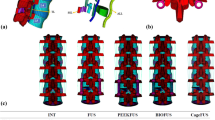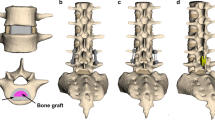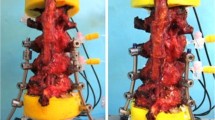Abstract
Purpose
The aims of the present study were to compare the biomechanical effects on the adjacent segments after mono-segmental floating fusion with posterior semi-rigid or rigid stabilization, and to evaluate the effect of the amount of fusion mass on the biomechanical differences.
Methods
A detailed, nonlinear L1–S1 finite element model had been developed and validated. Then five models were reconstructed by different fixation techniques on the L3–L4 level: rigid fixation with an interbody spacer (Ti + IS), rigid fixation with a large interbody spacer (Ti + IS_all), semi-rigid fixation with an interbody spacer (PEEK + IS), semi-rigid fixation with a large interbody spacer (PEEK + IS_all), and semi-rigid fixation only (PEEK). Analyses were conducted for the case of erect standing position, flexion, and extension motion.
Results
At L1–L2 and L2–L3, PEEK + IS demonstrated less inter-segmental rotation and nucleus pressure increments from the intact model compared with Ti + IS. The L4–L5 and L5–S1 levels showed slightly higher values with PEEK + IS, but these differences among the instrumented models were not significant. The motion difference based on the fusion mass at the adjacent levels was at most 3 %. All instrumentation cases generated a 55 % higher facet contact force at the lower adjacent level (L4–L5) compared to that of the intact model during 26° extension and the largest increment was detected at the upper adjacent level (L2–L3) in the Ti + IS. Instrumentation with Ti + IS markedly increased the stress in the intervertebral disk at the upper adjacent level, while the stress with PEEK + IS appeared largest at the lower adjacent level.
Conclusions
Posterior instrumentation with semi-rigid rods may lower the incidence of disk and facet degeneration in the upper adjacent segment compared to rigid rods. On the other hand, the possibility of facet degeneration will be similar for all instrumentation devices in the lower adjacent segment in the long-term. The stiffness difference between rigid and semi-rigid rods on the changes in the adjacent motion segments was more crucial than amount of fusion mass.









Similar content being viewed by others
References
Ghiselli G, Wang JC, Bhatia NN, Hsu WK, Dawson EG (2004) Adjacent segment degeneration in the lumbar spine. J Bone Joint Surg Am 86-A(7):1497–1503
Sears WR, Sergides IG, Kazemi N, Smith M, White GJ, Osburg B (2011) Incidence and prevalence of surgery at segments adjacent to a previous posterior lumbar arthrodesis. Spine J 11(1):11–20
Lee CS, Hwang CJ, Lee SW, Ahn YJ, Kim YT, Lee DH, Lee MY (2009) Risk factors for adjacent segment disease after lumbar fusion. Eur Spine J 18(11):1637–1643
Okuda S, Miyauchi A, Oda T, Haku T, Yamamoto T, Iwasaki M (2006) Surgical complications of posterior lumbar interbody fusion with total facetectomy in 251 patients. J Neurosurg Spine 4(4):304–309
Cheh G, Bridwell KH, Lenke LG, Buchowski JM, Daubs MD, Kim YJ, Baldus C (2007) Adjacent segment disease following lumbar/thoracolumbar fusion with pedicle screw instrumentation: a minimum 5-year follow-up. Spine 32(20):2253–2257
Min JH, Jang JS, Lee SH (2007) Comparison of anterior- and posterior-approach instrumented lumbar interbody fusion for spondylolisthesis. J Neurosurg Spine 7(1):21–26
Lai PL, Chen LH, Niu CC, Fu TS, Chen WJ (2004) Relation between laminectomy and development of adjacent segment instability after lumbar fusion with pedicle fixation. Spine 29(22):2527–2532
Kwon BK, Elgafy H, Keynan O, Fisher CG, Boyd MC, Paquette SJ, Dvorak MF (2006) Progressive junctional kyphosis at the caudal end of lumbar instrumented fusion: etiology, predictors, and treatment. Spine 31(17):1943–1951
Edwards CC 2nd, Bridwell KH, Patel A, Rinella AS, Kim YJ, Berra AB, Della Rocca GJ, Lenke LG (2003) Thoracolumbar deformity arthrodesis to L5 in adults: the fate of the L5–S1 disc. Spine 28(18):2122–2131
Sudo H, Oda I, Abumi K, Ito M, Kotani Y, Minami A (2006) Biomechanical study on the effect of five different lumbar reconstruction techniques on adjacent-level intradiscal pressure and lamina strain. J Neurosurg Spine 5(2):150–155
Chosa E, Goto K, Totoribe K, Tajima N (2004) Analysis of the effect of lumbar spine fusion on the superior adjacent intervertebral disk in the presence of disk degeneration, using the three-dimensional finite element method. J Spinal Disord Tech 17(2):134–139
Bastian L, Lange U, Knop C, Tusch G, Blauth M (2001) Evaluation of the mobility of adjacent segments after posterior thoracolumbar fixation: a biomechanical study. Eur Spine J 10(4):295–300
Rohlmann A, Burra NK, Zander T, Bergmann G (2007) Comparison of the effects of bilateral posterior dynamic and rigid fixation devices on the loads in the lumbar spine: a finite element analysis. Eur Spine J 16(8):1223–1231
Galbusera F, Bellini CM, Anasetti F, Ciavrro C, Lovi A, Brayda-Bruno M (2011) Rigid and flexible spinal stabilization devices: a biomechanical comparison. Med Eng Phys 33(4):490–496
Turner JL, Paller DJ, Murrell CB (2010) The mechanical effect of commercially pure titanium and polyetheretherketone rods on spinal implants at the operative and adjacent levels. Spine 35(21):E1076–E1082
Goel VK, Kim YE, Weinstein J, Lim T-H (1988) An analytical investigation of the mechanics of spinal instrumentation. Spine 13(9):1003–1011
Kim YE, Goel VK, Weinstein JN, Lim TH (1991) Effect of disc degeneration at one level on the adjacent level in axial mode. Spine 16(3):331–335
Chung SK, Kim YE, Wang KC (2009) Biomechanical effect of constraint in lumbar total disc replacement: a study with finite element analysis. Spine 34(12):1281–1286
Brinkley-Parsons D, Glimcher MJ (1984) Is the chemistry of collagen in intervertebral disc an expression of Wolff’s law? Spine 9(2):148–163
Ebara S, Iatridis C, Setton A, Foster J, Mow C, Weidenbaum M (1996) Tensile properties of nondegenerate human lumbar annulus fibrosus. Spine 21(4):452–461
Digimation, Inc. (2009) Digimation Premier Anatomy Collection - Man 8. Digimation, Inc., Florida
Victor MS, David GW (1998) Atlas of the visible human male: Reverse engineering of the human body. Jones and Bartlett Publishers Inc., London
White AA, Panjabi MM (1990) Clinical biomechanics of the spine. Lippincott Williams & Wilkins, Philadelphia
Yamamoto I, Panjabi MM, Crisco T (1989) Three dimensional movements of the whole lumbar spine and lumbosacral joint. Spine 14(11):1256–1260
Panjabi MM, Oxland TR, Yamamoto I, Crisco JJ (1994) Mechanical behavior of the human lumbar and lumbosacral spine as shown by three-dimensional load-displacement curves. J Bone Joint Surg Am 76(3):413–424
Moramarco V, Pérez del Palomar A, Pappalettere C, Doblaré M (2010) An accurate validation of a computational model of a human lumbosacral segment. J Biomech 43(2):334–342
Wilke H, Neef P, Hinz B, Seidel H, Claes L (2001) Intradiscal pressure together with anthropometric data-a data set for the validation of models. Clin Biomech 16(Suppl 1):S111–S126
Wilke HJ, Neef P, Caimi M, Hoogland T, Claes LE (1999) New in vivo measurements of pressures in the intervertebral disc in daily life. Spine 24(8):755–762
Dreischarf M, Zander T, Bergmann G, Rohlmann A (2010) A non-optimized follower load path may cause considerable intervertebral rotations. J Biomech 43(13):2625–2628
Rohlmann A, Zander T, Rao M, Bergmann G (2009) Applying a follower load delivers realistic results for simulating standing. J Biomech 42(10):1520–1526
Panjabi MM (2007) Hybrid multidirectional test method to evaluate spinal adjacent-level effects. Clin Biomech 22(3):257–265
Rohlmann A, Zander T, Rao M, Bergmann G (2009) Realistic loading conditions for upper body bending. J Biomech 42(7):884–890
Gornet MF, Chan FW, Coleman JC, Murrell B, Nockels RP, Taylor BA, Lanman TH, Ochoa JA (2011) Biomechanical assessment of a PEEK rod system for semi-rigid fixation of lumbar fusion constructs. J Biomech Eng 133(8):081009
Frymoyer JW, Hanlyey J, Kuhlmann D, Matteri R (1979) A comparison of radiographic findings in fusion and nonfusion patients ten or more year following lumbar disc surgery. Spine 4(5):435–440
Inoue S, Watanabe T, Goto S, Takahasi K, Takata K, Sho E (1988) Degenerative spondylolisthesis, pathophysiology and results of anterior interbody fusion. Clin Orthop 227(2):90–98
McGill SM, Hughson RL, Parks K (2000) Changes in lumbar lordosis modify the role of the extensor muscles. Clin Biomech 15(10):777–780
Acknowledgments
This research was supported by the Basic Science Research Program through the National Research Foundation of Korea (NRF) funded by the Ministry of Education, Science and Technology (No. 2011-0001142 and No. 2012R1A1A2008948).
Conflict of interest
None.
Author information
Authors and Affiliations
Corresponding author
Rights and permissions
About this article
Cite this article
Jin, Y.J., Kim, Y.E., Seo, J.H. et al. Effects of rod stiffness and fusion mass on the adjacent segments after floating mono-segmental fusion: a study using finite element analysis. Eur Spine J 22, 1066–1077 (2013). https://doi.org/10.1007/s00586-012-2611-6
Received:
Revised:
Accepted:
Published:
Issue Date:
DOI: https://doi.org/10.1007/s00586-012-2611-6




